
MAY CONTAIN NUTS

Search Shorpy
SHORPY ART

Framed or unframed, desk size to sofa size, printed by us in Arizona and Alabama since 2007. Explore now.
Join and Share
Ad-Free Shorpy
Shorpy is funded by you. Patreon contributors get an ad-free experience.
Learn more.

Recent comments
- Baldwin 62303
- Baldwin VO-1000
- Cold
- No expense spared
- Tough Guys
- Lost in Toyland
- And without gloves
- If I were a blindfolded time traveler
- Smoke Consumer Also Cooks
- Oh that stove!
- Possibly still there?
- What?!?
- $100 Reward
- Freeze Frame
- Texas Flyer wanted
- Just a Year Too Soon
- WWII -- Replacing men with women at the railroad crossing.
- Yes, Icing
- You kids drive me nuts!
- NOT An Easy Job
- I wonder
- Just add window boxes
- Icing Platform?
- Indiana Harbor Belt abides
- Freezing haze
- Corrections (for those who care)
- C&NW at Nelson
- Fallen Flags
- A dangerous job made worse
- Water Stop
Member Photos
The Shorpy
Print Emporium
Print Emporium
Search Shorpy
Search results -- 30 results per page
- Bananamerica: 1942
- ... it while having a limeade.
Split Decisions I'm from Chicago, and at the Dairy Queen my parents took my sister and I to sometimes ... Posted by Dave - 09/18/2017 - 4:17pm -
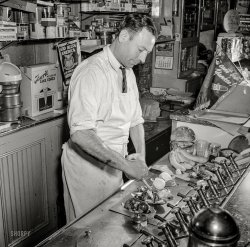
- Thurston Lee: 1943
- ... California. "Brakeman Thurston H. Lee (whose home is in Chicago) going to bed at the reading room in Barstow, California. This room has ... perhaps braking on the Chief or Super Chief out of Chicago. But if so, what‘s he doing in a bunk house---er, sorry, I mean ... Posted by Dave - 12/26/2012 - 9:56pm -
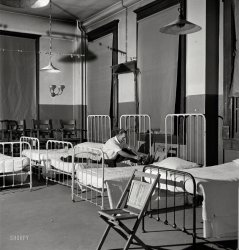
- BOT: 1906
- ... & Root's most important commission in Kansas City. The Chicago firm won an architectural competition held for the project in 1886; the ... Posted by Dave - 08/15/2012 - 4:15pm -
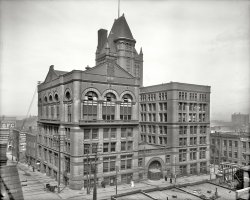
- Louisville Wharfboat: 1905
- ... bridge which was built to carry the Cleveland, Cincinnati, Chicago and St. Louis railroad (Big Four) across the Ohio River. If it is the ... Posted by Dave - 07/07/2014 - 12:47pm -
![Louisville Wharfboat: 1905 Circa 1905. "Ohio River levee at Louisville, Kentucky." Note the "U.S. Life Saving Station." 8x10 inch glass negative, Detroit Publishing Company. View full size.
Connected finallyThe Big 4 bridge in the background is now a pedestrian bridge connecting the 2 sides (finally). It's a great addition to downtown.
Busy!There sure is a lot going on in this photo!
Still afloat!The Life Saving Station(#10) is still there and is now used as the wharfboat for the historic sternwheeler Belle of Louisville.
[The present Life Saving Station #10 dates from 1929. -tterrace]
Ol' Reliable That Old Reliable Laundry cart in the middle looked pretty new - so I looked and found a Google Book's result that said it was Organized Aug, 4, 1904, for $3,000 and paid $3 in tax. So, the cart (or the paint job on the cart) was probably a year old or so old when the picture was taken.
Railroad BridgeThe bridge in the background appears to be the "Big Four" bridge which was built to carry the Cleveland, Cincinnati, Chicago and St. Louis railroad (Big Four) across the Ohio River. If it is the Big Four bridge it is the first one; the bridge became inadequate for the traffic and was replaced in the late twenties. The Big Four eventually was merged into the New York Central and railroad traffic on the bridge was ceased. In recent years the bridge has been restored to allow pedestrian and bicycle traffic to cross the river.
(The Gallery, Boats & Bridges, DPC, Louisville)](https://www.shorpy.com/files/images/SHORPY-4a22248a.thumbnail.jpg)
- Long Train Running: 1900
- ... Circa 1900. "Steel viaduct over Des Moines River, Iowa -- Chicago & North Western Railway." 8x10 glass negative by William Henry ... Posted by Dave - 10/20/2016 - 5:23pm -
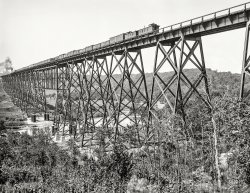
- The Prudential: 1956
- ... In contrast, the 1955 Prudential Building building in Chicago is a modern tower, the first post-WWII skyscraper in the city.
... Posted by Dave - 11/19/2019 - 11:22am -
![The Prudential: 1956 January 25, 1956. "Prudential Insurance Co., Newark, New Jersey. From Public Service roof." 4x5 inch acetate negative by Gottscho-Schleisner. View full size.
Two spaces after periodsand one after commas is what I learned in typing class many moons ago. I took the class in summer school for some extra credit, but I'm such a physical klutz that I almost ruined my GPA. Fortunately, I finally pulled things out of the fire. Thank heavens for PC's, where you can correct your errors without using white-out. I see that my comments have the two spaces reduced to one automatically -- this results in a failure if I were to submit it to my typing teacher.
Previously on Shorpy - The Prudential: 1955In contrast, the 1955 Prudential Building building in Chicago is a modern tower, the first post-WWII skyscraper in the city.
Picture here: Michigan Avenue: 1962
SignsNice logo placement!
Ghost imageWhat a wonderful remnant of the previous building.
Shorpy SignOnce aqain, love the Shorpy roof sign, in proper perspective, no less.
Cornering the marketThe building on the left was the Prudential main building , built in 1892 . The one on the right was Prudential north , built circa 1910 . Academy Street between . Both these buildings were demolished later in 1956 . The present 24 story Prudential Plaza was built on the site of Prudential Main, 751 Broad Street . It opened in 1960 . Prudential also built the Gibraltar , the Prudential Center and the new Prudential Tower . All within a half mile radius .
[WHY THE SPACES IN FRONT OF YOUR COMMAS AND PERIODS? - Dave]
(The Gallery, Gottscho-Schleisner)](https://www.shorpy.com/files/images/SHORPY-5a24190u.thumbnail.jpg)
- Working Mother: 1943
- ... mother of two, employed at the roundhouse as a wiper, Chicago & North Western R.R." 4x5 Kodachrome transparency by Jack Delano ... Posted by Dave - 08/30/2012 - 4:48pm -
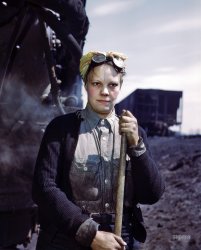
- Blizzard of 1918
- East Chicago, Indiana, January, 1918. The Chicago, Lake Shore and South Bend Interurban Railroad. Volunteers and railroad ... The South Shore ran on the principal east-west street, Chicago Avenue. Along with South Bend to Chicago trains, a 3.4-mile streetcar ... Posted by Pete Miksich - 04/03/2015 - 6:52pm -
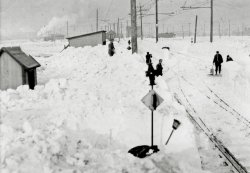
- Black & White: 1922
- ... cabs were made by the Yellow Cab Manufacturing Company of Chicago which was owned by John Hertz. The logo on the radiator looks almost ... Posted by Dave - 07/23/2013 - 5:44pm -
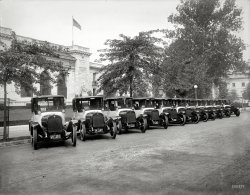
- Road Trip: 1926
- ... roads, Dad told of an emergency trip he made with it, from Chicago to Owensboro, KY, averaging over 60 MPH. Likely impossible on today's ... Posted by Dave - 12/14/2013 - 11:28am -
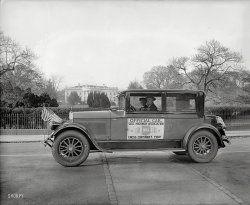
- Goat Cart: c. 1915
- My father, William John Hager, in the Chicago area, riding in a wagon pulled by a goat. Circa 1915. View full size. ... one when dad bought a new Studebaker wagon. In a city like Chicago that wouldn't be very likely unless your dad lived in a very rural area ... Posted by hager2007 - 02/02/2010 - 9:55am -
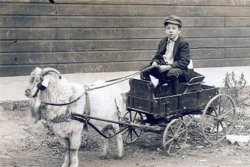
- Lake Front Depot: 1899
- Milwaukee circa 1899. "Chicago & North Western Railway Station." Romanesque Revival structure on ... Posted by Dave - 03/15/2018 - 6:59pm -
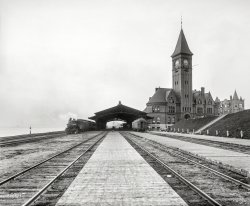
- Women Wipers: 1943
- May 1943. Clinton, Iowa. " Women wipers of the Chicago & North Western Railroad going out to work on an engine at the ... Posted by Dave - 02/02/2014 - 3:33pm -
![Women Wipers: 1943 May 1943. Clinton, Iowa. "Women wipers of the Chicago & North Western Railroad going out to work on an engine at the roundhouse." Medium-format negative by Jack Delano for the Office of War Information. View full size.
PerspectiveThis really gives the viewer an idea of just how monstrously big that engine was!
TerrificJust terrific!
More Big Boys!As this shows up while Union Pacific 4014 is in transit to Cheyenne Wyoming for restoration, it would be nice to see more photos of the Big Boys in their heyday - and more of the Women Wipers too!
[Click the link in the caption. - Dave]
Not to diminish the size... of a steam locomotive, but the women are farther away from the front of the locomotive than it seems; a man standing beside that steam cylinder would almost be as tall as the cylinder. Steam locomotives were large indeed.
(The Gallery, Jack Delano, Railroads)](https://www.shorpy.com/files/images/SHORPY_8d29250u.thumbnail.jpg)
- Ray Schalk: 1914
- ... other half of the battery for four no-hit games by various Chicago pitchers during his career. Ty Cobb thought highly of Schalk, naming ... Schalk caught a ball dropped from the top of the 462 ft. Chicago Tribune tower. 'Cause he could, I guess.
Denny Gill
Chugiak, ... Posted by Dave - 03/07/2008 - 5:17pm -
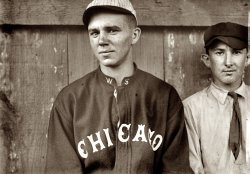
- Heavy Lifting: 1910
- ... five years later using a unique system developed by noted Chicago marine contractor Jacob Sensibar. The Constitution ended its career ... Posted by Dave - 08/01/2014 - 9:05am -
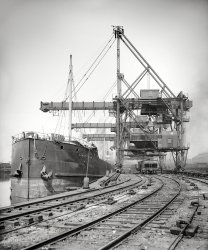
- Johnny Evers: 1910
- Chicago Cubs second baseman Johnny Evers. December 16, 1910. Gelatin silver ... Posted by Dave - 07/29/2012 - 7:11pm -
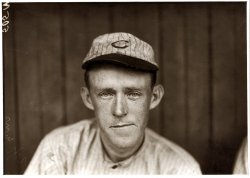
- Bathtime for Baby H
- ... April 1943. "Viola Sievers, one of the wipers at the Chicago & North Western roundhouse, giving a giant "H" class locomotive a ... Posted by Dave - 08/30/2012 - 7:41pm -
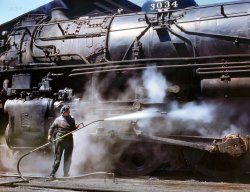
- The Sopranos: 1920
- ... studied with Caruso in New York. He persuaded the Chicago opera to hire her, however she developed voice problems and had to ... Posted by Dave - 09/13/2011 - 4:36pm -
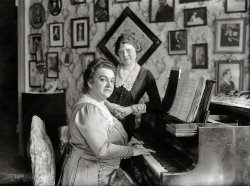
- Strange Fourth: 1955
- ... down memory lane.
I just moved from Santa Rosa to Chicago and I have fond memories myself.
On the sand? When I was a kid, ... Posted by tterrace - 11/27/2017 - 1:29pm -
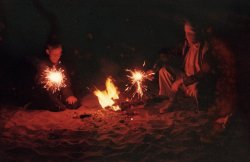
- Hotshots: 1962
- ... photographer or two from either Columbus, Georgia, or Chicago. One thing we know for certain is that the camera is a Mamiyaflex. 4x5 ... Posted by Dave - 08/26/2015 - 2:31am -
![Hotshots: 1962 Circa 1962, a newspaper photographer or two from either Columbus, Georgia, or Chicago. One thing we know for certain is that the camera is a Mamiyaflex. 4x5 acetate negative from the Shorpy News Archive. View full size.
Film size correctionThe Mamiyaflex film size is actually 2.25" x 2.25" Or it was also referred to as the 6 x 6 for the centimeter folks.
[4x5 in the caption refers to the negative size of this photo, not that of the camera in the photo. -tterrace]
[The kids these days think everything is a selfie! Thank you, tterrace. - Dave]
I owned a later version of this same camera in the 70s, a Mamiyaflex 330. It was a great medium format camera and had actual interchangeable lenses too. Not the "screw on the front of the normal lens" kind. In addition to the normal 80mm lens I also had a wide angle and telephoto lens to increase the versatility.
Edit: Sorry, read it too quickly and missed that all important period at the end of the sentence.
Twin lens starThe Mamiyaflex offered alternate focal length twin-lens assemblies that could be changed without removing the roll film. An outstanding camera which was a logical step up for this twin-lens fan. First, the modest Ciroflex, then a Rolleicrord followed by a Rolleiflex and then a Yashicamat. All producing 2-1/4 X 2-1/4 negatives on 120 film. The Mamiyflex had superb optics.
All but one!ManyBuicks, I hate to admit this, but I owned and loved all of those except for the Ciroflex. The Mamiya was awesome and I had three lenses for it and a bunch of other goodies. Great glass and I used that system until about 1991. I loved twin-lens cameras.
All but one!ManyBuicks, I hate to admit this, but I owned and loved all of those except for the Ciroflex. The Mamiya was awesome and I had three lenses for it and a bunch of other goodies. Great glass and I used that system until about 1991. I loved twin-lens cameras.
Film size?So, does the camera use 120 film? What's with the 4x5 comparison?
[The Mamiyaflex the man on the left is holding uses 120 roll film. This photo of the two men was made with a camera that uses 4x5 sheet film, and this is a scan of that negative. -tterrace]
Something's MissingNeither of them is wearing a hat that has a little card that says "PRESS" sticking out of it!
(The Gallery, News Photo Archive)](https://www.shorpy.com/files/images/SHORPY-409-01A.thumbnail.jpg)
- Tastee Drinks: 1942
- ... at least by today's standards. At the same time in Chicago, Jap's potato chips suddenly felt the urge to change their brand name ... Posted by Dave - 07/18/2019 - 9:44am -
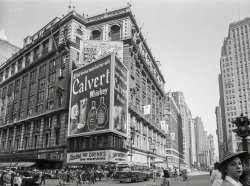
- Fenders Fixed: 1920
- ... LaPorte, Indiana, married Elsie Standring in 1890 in the Chicago area, and came west in 1898 to visit his brother who was a manager at a ... Posted by Dave - 04/27/2016 - 1:55pm -
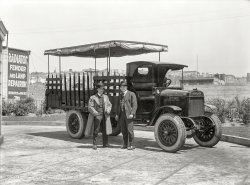
- En Famille: 1941
- ... penny
So fa ... so good My very first apartment in Chicago had that very same sofa bed, complete with the same upholstery. Didn't ... Posted by Dave - 10/05/2018 - 11:23am -
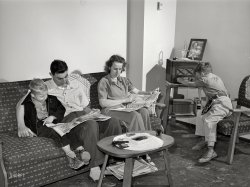
- Clinton Iowa, 1956
- ... remember hearing "Poor Little Fool", Rick Nelson, on WBBM, Chicago. This was in the days that WBBM was a music station.
Time and Tide ... Posted by HankHardisty - 09/19/2011 - 2:14pm -
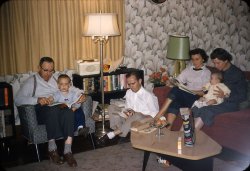
- White Hall Nationals: 1896
- ... McFarland
Later, Monte McFarland was a member of the Chicago Cubs and Charles McFarland was a member of the St. Louis Cardinals.
... greatest legend of this era. He pitched for Cap Anson's Chicago Colts. Anson was a spectacular player and manager. He was also widely ... Posted by KwaKeeSirPeeNeeKu - 09/20/2011 - 11:57pm -
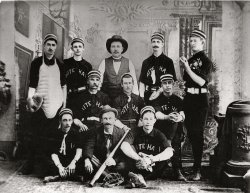
- Lil Champ: 1947
- ... Stays Pumped Up About The Benefits Of Exercise
(Chicago Tribune -- Oct. 7, 1990)
Early Kubrick Stanley Kubrick was still ... Posted by Dave - 04/28/2017 - 7:40am -
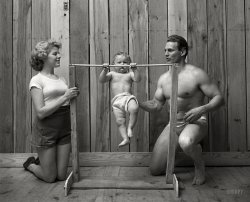
- Santa's Railyard: 1943
- ... by Jack Delano, taken on his Santa Fe rail trip west from Chicago in 1943. His description of this scene: "Activity in the Santa Fe R.R. ... Posted by Dave - 08/06/2012 - 11:10pm -
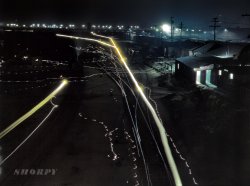
- Cozy Depot: 1943
- January 1943. "Freight train operations on the Chicago & North Western Railroad between Chicago and Clinton, Iowa. At the end of the trip, conductor John Wolfsmith ... Posted by Dave - 01/08/2014 - 10:29am -
![Cozy Depot: 1943 January 1943. "Freight train operations on the Chicago & North Western Railroad between Chicago and Clinton, Iowa. At the end of the trip, conductor John Wolfsmith [last seen here] waits at the little railroad station for a suburban train to take him back home to Chicago. A welder who works at the rip tracks is trying to thaw out his frozen air hose." Medium-format negative by Jack Delano for the Office of War Information. View full size.
(The Gallery, Jack Delano, Railroads)](https://www.shorpy.com/files/images/SHORPY_8d24470a.thumbnail.jpg)
- Under the Hood: 1943
- ... be an exhibit of DeLano’s railroad photographs at the Chicago History Museum, April 5, 2014 to August 10, 2015.
Gotta love a ... Posted by Dave - 03/26/2014 - 9:59am -
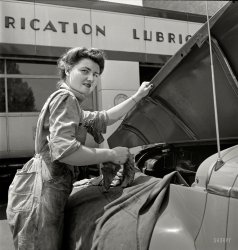
- Product Launch: 1905
- ... was intended to compete for the Canada's Cup races at Chicago, but failed to qualify, losing to another Detroit boat, the Cadillac. ... Posted by Dave - 12/05/2014 - 12:12pm -
![Product Launch: 1905 Circa 1905. "Launching of the Detroit (Detroit Yacht Club)." 8x10 inch glass negative by Lycurgus S. Glover, Detroit Publishing Co. View full size.
A ChampionIn August of 1905 the yacht Detroit won the Lipton Cup in San Diego.
[Steeped in history! - Dave]
This Detroit boat looks so modernJust I wanted to write. Very modern boat as almost 110 years old. Very streamlined.
Happy DaysQ: What are the two happiest days of a sailing man's life?
A: The day he buys his own boat and the day he sells it.
The precise date of this photograph isJune 4, 1901, and shows the launching of the Detroit at the yard of the Michigan Yacht & Power Company, situated just south of Jefferson Avenue on the Detroit River just east of downtown. The boat had been commissioned by a Detroit syndicate headed by Alex McLeod, shipowner, former newspaper editor, founder of the Detroit Telephone Company, and Commodore of the Detroit Yacht Club. The vessel was intended to compete for the Canada's Cup races at Chicago, but failed to qualify, losing to another Detroit boat, the Cadillac. It was sold in Spring 1904 to a San Diego syndicate, sent west by rail, underwent some modifications, and, as already indicated here, quickly became one of the premier racing yachts on the Pacific coast, but for only a brief time, as her design and ownership raised questions among Southern California's racing elite and she was banished from racing by 1906.
(The Gallery, Boats & Bridges, Detroit Photos, DPC)](https://www.shorpy.com/files/images/SHORPY-4a14844a.thumbnail.jpg)























